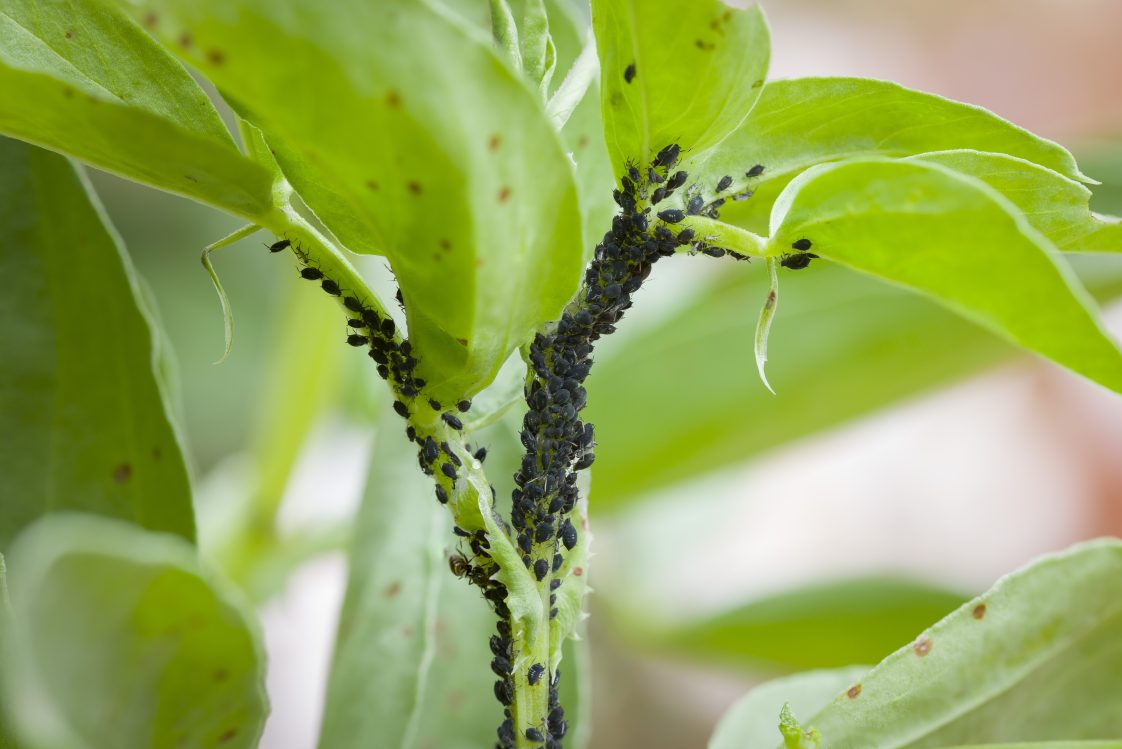Lawn & Garden

How can I keep “bad” bugs out of my garden and attract “good” bugs? How can I control slugs and other soil insect pests? What insect pests and predators are common to Alabama? How can I decrease pest populations without insecticides?
Pest management strategies in the home vegetable garden depend on how tolerant the gardener is to pest damage on their vegetables. No garden can be 100 percent free of pest damage, but most people can tolerate some damage to their vegetables in lieu of applying pesticides. Consequently, many nonchemical control strategies may reduce insect damage. Home gardeners may use chemical controls when nonchemical methods are insufficient to keep pest populations below damaging levels.
Correct identification of insect pests is critical to developing a management plan. Equally important is the recognition of beneficial insects. Your county Extension office can help you identify pests and develop management strategies for specific pests and crop situations.
This document provides the following:
- Tips on making your garden vegetables less susceptible to insect damage
- General recommendations for managing soil pests
- General recommendations for managing aboveground pests
Making Your Garden Vegetables Less Susceptible to Insect Damage
In home vegetable gardens, insecticides should be used sparingly and applied only to the affected plants. Insecticides can kill beneficial insects as well as harmful insect pests. You can eliminate or reduce the need for insecticides in your garden by using various alternative management techniques. The best overall strategy is to enhance floral diversity to support diverse insects and provide habitat for predators at all times, even after some crops are harvested. Flowers attract both good and bad insects, so monitoring pest populations is essential when implementing floral diversity. Over time the good insects should help keep bad insects below damaging thresholds, but this should not be your only pest management strategy.
Healthy Soil
Healthy soil helps to ensure that plants are better able to resist insects and diseases. Before planting in new soil, have a soil sample evaluated to learn what nutrients are present or lacking; this way you can adjust the composition to benefit the vegetables you are planting. You may want to turn over the soil and add organic matter such as manure or compost to supply essential nutrients. Soil testing can be done for a nominal fee (see “Home Soil Testing” on the Alabama Extension website at www.aces.edu).
Crop Rotation
Varying the location of each kind of vegetable in your garden annually helps to reduce pest infestation. Some insect pests overwinter in the garden soil and emerge the following year to search for food. If the plant they prefer to eat is located several yards away, the insect is less likely to find its primary food. Other plants create physical and chemical barriers, or the pests may die or fall prey to birds and other insect predators.
Many vegetables absorb particular nutrients from the soil. By rotating your vegetable crops each year, the soil in a particular section of the garden can rest and regenerate.
In general, avoid planting crops in the same plant family in the same location in consecutive years. For example, potato, eggplant, and tomato are all in the nightshade (Solanaceae) family, so these crops should be rotated with vegetables in another plant family, such as the squash or cucurbit (Cucurbitaceae) family, the bean or legume (Fabaceae) family, etc.
Trap Plants
If given a choice, some insects prefer one specific plant type over another. For example, pickleworms prefer squash over cucumber, and some tomato worms prefer dill over tomato.
With a little knowledge of host preferences, you can place certain plants where they can lure harmful insects away from the plants you wish to protect. Once these trap plants become infested, the target insect can be picked off and dropped in soapy water, or the entire plant can be destroyed. This may be a good option if you can walk through your small garden daily.
Barriers and Traps
Barriers and traps can be employed to capture or impede movement of pests. A collar made of thick paper or cardboard placed around the stem of a plant and pressed into the soil an inch or so deep prevents cutworms and other burrowing insects from getting into the soil around your plants. Yellow sticky cards attract and intercept aphids, whiteflies, and other small flying insects.
Mulch
Mulching is the spreading of organic matter in the garden and around plants. It is an effective method to control weeds. It also serves as a refuge for predatory insects, such as ground beetles. Mulch helps the soil retain moisture and stay cool, promoting plant vigor and resistance to insect attack.
Add mulch to the garden when plants are 4 to 6 inches high. Grass clippings, leaves, hay, sawdust, wood chips, and compost make excellent mulches. One drawback of using mulch may be increased numbers of slugs that feed on young and succulent plants.
Plastic or cloth mulch is available but can be more costly. An advantage is that it can be placed in the garden early on in the growing season. Transplants at any height can then be placed directly into the garden. Make sure plants are able to get water via bare ground row middles or manual watering, as cloth or plastic mulch may not allow water to permeate through to the plants.
Compost
Fertile soil is the foundation of a healthy garden. One of the most effective ways to enhance soil fertility is to add compost. Compost is made by mixing organic matter and allowing it to decay through a natural process. The end product is a dark, rich substance called humus, which can be added directly to the soil.
The first step in composting is to build a holding bin or composter. Construct the bin from chicken wire, scrap wood, or cinder blocks. The dimensions should be at least 3 × 3 × 3 feet but can vary depending on your needs.
Place the bin in a convenient location. Add leaves, grass clippings, and household vegetable food waste. Do not add animal residues as they may attract rats and raccoons. Turn the pile to aerate the material. If you turn the pile every month, humus will be ready in about 6 months.
Fertilizers (synthetic or organic sourced) may be an option if you have a small yard where space for a compost pile is limited or you need to boost plant growth immediately and no compost is available. Turning compost piles may be physically difficult, so buying commercial compost or fertilizer may be the best option in such situations.
Agriculturally Beneficial Insects
Very few insects are pests (“bad” bugs). Your garden and surroundings contain many insects that are beneficial because they feed on garden pest insects. As a gardener, you should be able to identify garden insects and determine whether they are pests or predators.
Many gardening books provide pictures of the most common beneficial and pest insects and information on how to encourage populations of beneficial insects, which are called natural enemies. To sustain natural enemies of crop pests, you need to retain their prey somewhere in your garden ecosystem.
A good reference book with pictures of beneficial insects is Natural Enemies of Vegetable Insect Pests by Michael Hoffman and Anne Frodsham. Another excellent reference is Habitat Planning for Beneficial Insects: Guidelines for Conservation Biological Control. The app Seek by iNaturalist is also very helpful for identification.
Perennial plants may provide nectar and pollen resources to beneficial insects and provide them harborage for the winter months. Be sure to plant a variety of flowers with bloom times in spring, summer, and fall. Be aware that bad bugs also will be attracted to these resources, and pest populations may overcome the beneficial insects. Scouting for pest populations in the garden as well as in these floral areas is essential to keep pest populations at bay. If pests become overwhelming, you may want to remove these flowers to deter more insects from being attracted to the heavily infested areas.
Over time beneficial insect populations may rebound and bring pest insect populations back to a controllable population. Until that time you may have to provide other pest control measures within the garden to avoid severe crop damage. Scouting for pests and beneficial insects must become a part of your gardening routine.
Table 1. Attracting Agriculturally Beneficial Insects aka Natural Enemies of Crop Pests
| Name of Beneficial Insect | Prey | Methods to Attract |
|---|---|---|
| Ladybug | Adults and larvae eat aphids, scales, mites, and eggs of some pest insects. | Grow pollen and nectar plants, such as dill, goldenrod, yarrow, cosmos, and sweet alyssum. Provide water in a pan filled with gravel during dry periods. |
| Hover fly | Larvae feed on aphids and small caterpillars. | Grow pollen and nectar plants in the parsley (Umbelliferae) or aster (Asteraceae) families. Allow crops, such as broccoli, lettuce, and cabbage, to flower. Plant tall plants, such as sunflower, so that adult flies can hover. |
| Robber fly | Adults capture flying insects. Larvae live in soil and feed on soil pests such as grubs. | A wide assortment of flowering plants serve as a nectar source. |
| Ground beetle | Adults feed on snails, slugs, cutworms, and other caterpillars, and on potato beetle eggs and larvae. | Grow pollen-providing plants. Grow dense cover crops, such as clover, to provide shelter. Incorporate grass or stone walkways between garden beds. |
| Big-eyed bug, flower bug | Adults eat aphids, small caterpillars, mites, turf pests, thrips, and other small insects. | Grow pollen and nectar plants, such as sweet alyssum, alfalfa, goldenrod, and cosmos. |
| Assassin bug | Both nymphs and adults use their needlelike stylets to suck fluids from and kill aphids and other small insects and their eggs. Larger wheel bugs attack large caterpillars. | Grow perennials to provide permanent shelter plantings. |
| Lacewing (green and brown) | Larvae eat aphids, scales, thrips, mites, and eggs of some pest insects. | Plant dill, sunflowers, caraway, cosmos, sweet alyssum, and goldenrod flowers. |
| Tachinid fly | Larvae are parasites of squash bugs, cutworms, Japanese beetles, and many caterpillars. | Grow plants in the parsley (Umbelliferae) family and other small-flowered plants, such as sweet alyssum and spearmint. |
| Wasp (predatory and parasitic; nonstinging to humans) | Adults inject eggs inside caterpillar prey; wasp larvae develop, eventually killing the host. Some species parasitize insect pest eggs. | Grow pollen and nectar plants in the parsley (Umbelliferae) family, mints, and culinary herbs. White clover and other legume cover crops planted adjacent to garden beds also attract parasitic wasps. Provide shelter with tall plants such as sunflowers. Let some broccoli and radishes flower. |
Managing Soil Pests & Supporting Soil Life in the Garden
General Recommendations
Soils host many more beneficial (predatory) than pest insects if managed well with diverse and rotational plantings. Healthy soil also supports diverse micro- organisms that improve plant vigor, help retain soil moisture, and improve soil quality. To learn more about diversity in soils see Farming with Soil Life: A Handbook for Supporting Soil Invertebrates and Soil Health.
Converting Turf Areas to Gardens
Some soil insect pest populations reach high numbers in grass or turf. If your garden is established in an area previously covered with grass, thoroughly till or spade the area 30 days or more in advance of planting and again just before planting. This brings soil pests up near the surface where their chances of mortality are increased. In most cases, tilling the soil or sod in fall and early spring sufficiently controls soil insects without the need for a soil insecticide. Depending on the crops grown, and if tilling is not an option, a cover crop rotation can help control cutworms, wireworms, or white grubs.
Slugs
Slugs like to feed on young seedlings and succulent parts of plants. They leave a trail of mucus on surfaces on which they crawl. Moist, humid environments favor slug development, and slugs usually overwinter in sheltered locations outdoors. They deposit their eggs in moist areas and require a year or more to mature.

Slug
0.5-4.0 in.
Ground beetles are excellent slug predators. Maintaining a beetle bank (permanent field border with vegetation close to the ground) can help keep slug populations in check.
- Spade or till garden area in the fall and again in the spring before planting.
- Pick slugs by hand. Using a flashlight, check the garden around 10 p.m. for active slugs. If you find any, pick them up with an old teaspoon. Place captured slugs in a container of salt or soapy water, which will kill them. Continue this activity for three or four nights in a row to greatly reduce damage.
- Place stale beer in small cups or pans sunken in the soil; the lip of the container should be slightly below ground level. Slugs are attracted to the beer, fall into the container, and drown. For best results, replace the stale beer about every 3 days. Setting out enough containers early in the spring can greatly reduce slug populations.
- Use diatomaceous earth, lime, or sawdust as a barrier; replace after each rain.
- Pesticide baits are minimally to moderately effective against slugs and may harm other wildlife or pets. To increase their effectiveness, apply baits late in the afternoon. Bait in the fall after the first rains to target slugs before they can lay eggs.
Cutworms
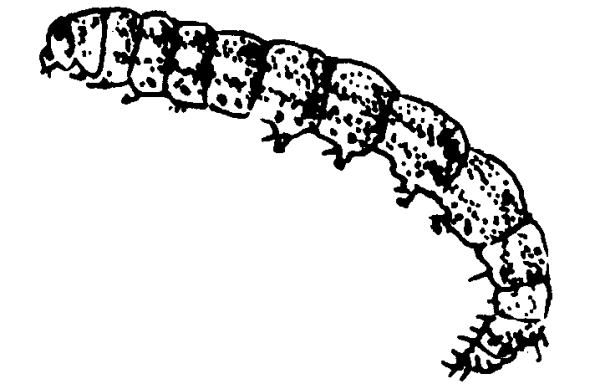
Cutworm
Cutworms are active only at night and remain buried below the soil surface near food plants during the day. They emerge to feed at night and often cut seedlings or small stems, causing the plants to fall over.
- Because grass and many weeds are preferred hosts, remove grass and weeds in the garden, and plow the soil well in advance of planting.
- Prevent seedling damage by placing a paper or plastic sleeve over the plant and pressing the bottom into the soil. Place sleeves around newly set transplants or newly emerged seedlings so that 1 inch is belowground and 3 inches aboveground. Paper cups with the bottoms removed or 4-inch-high sections of half-gallon paper milk cartons are ideal. Tuna cans with the bottoms removed may also work. If using carbaryl bait, apply after plant emergence in the afternoon according to label directions so that the bait is fresh when the worms come out to feed at night. Do not use near riparian or other wetlands due to high toxicity for aquatic life such as fish and stoneflies.
Wireworms
Wireworms are the slender, yellowish brown, hard- bodied larvae of click beetles. They can survive deep in the soil for up to 5 years and can move up to attack seeds or young plants. Several wireworm species prefer plants in the grass family and are usually not a problem unless the garden is planted into land that previously contained grasses or crops in the grass family.
- Turn over the soil in fall and again in spring well in advance of planting to help reduce wireworm populations.
- Cover crop rotations are the best approach to reduce populations, but granular insecticides are available including fungal bio pesticides that have fewer nontarget impacts. If applying granules, follow label directions and work them into the soil to a depth of 4 to 6 inches followed by a good watering.

Pacific Coast Wireworm
0.4 in.
White Grubs
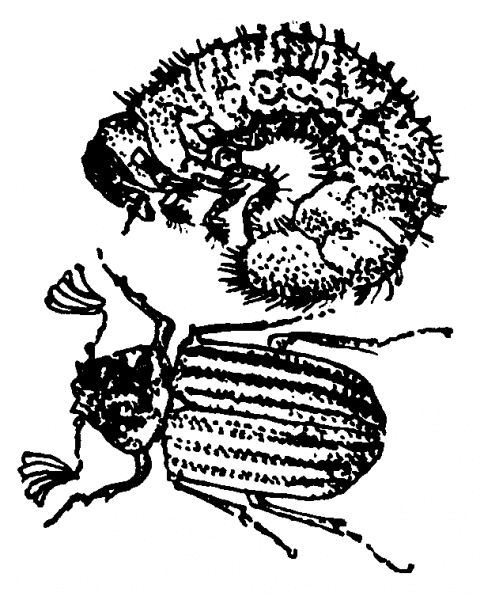
Larva, 0.5-2.0 in. (top)
Lined June Beetle, 0.9-1.1 in. (bottom)
White grubs are Japanese, May, and June beetle larvae that are creamy white in color. The tip of their abdomen is a blue-black color. Some solitary wasps lay their eggs in grub larvae, so providing habitat to support diverse insects is an important way to reduce grub populations.
White grub larvae roll into a C shape when disturbed. Mature grubs may reach 2 inches in length. They live in the soil and sometimes feed on plant roots and tubers. About the only time they are troublesome is when parts of the lawn or sod are turned under in the spring for garden use. If you must plant in previously grassy areas, prepare the garden well in advance. As sod is turned over, raked, and prepared for planting, handpick grubs for the best control.
Mole Crickets
Mole crickets have brown, velvety bodies with broad front legs for digging in soil. They have large eyes and are about 1 inch long when mature.
As mole crickets tunnel through soil, they can disrupt the root system of vegetables. They also may feed on plant roots and underground stem tissue.
Avoid planting your garden in previously grassy areas. If you observe mole cricket tunnels around plants, tamp the soil back down to restore support to the root system.
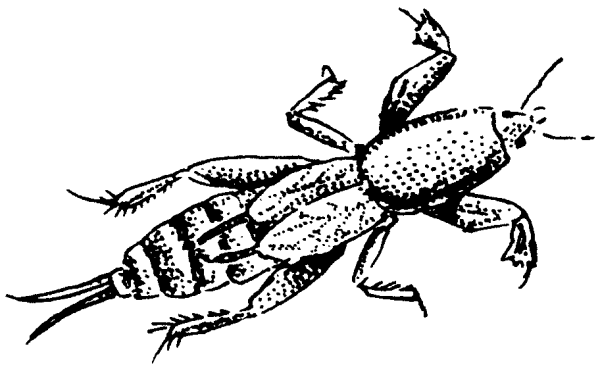
Mole Cricket
0.8-1.2 in.
Managing Aboveground Pests in the Garden without Chemicals
Aphids

Pea Aphid
0.12-0.17 in.
- To repel aphids, anchor aluminum foil to the soil for 1 foot around transplants. Slope soil away from plant so that rainwater and mud do not obscure reflective surface. You may remove foil after plants flower.
- Make a water trap by painting a small, shallow pan bright yellow and filling it with soapy water. Place several pans in the garden and refill after each rain. Monitor and remove pans if they are attracting more bees than aphids.
- Use yellow sticky cards to attract and trap flying and crawling aphids. Replace cards when full of insects.
- Hand remove and destroy aphid colonies on plant leaves.
- Use a strong spray of water from the hose to knock aphids from plants.
- Spray plants with ready-to-use (RTU) insecticidal soap or horticultural oil. Test tender plants first to ensure they are not burned by the soap or oil solution. Follow all label directions if using a concentrated product, and do not apply horticultural oils when it is above 80 degrees Fahrenheit.
- Because aphids can transmit plant virus disease, remove and destroy diseased plants to delay spread of virus to healthy plants.
Asparagus Beetles
- Destroy and bury plant refuse in the fall to remove overwintering sites.
- Handpick and destroy eggs, larvae, and adults in the morning before they become active.
- Spray asparagus ferns with pyrethrin or rotenone in late summer so that fewer beetles overwinter. Be aware, however, that these are broad spectrum and can harm beneficial pollinating and predatory insects, as well.
- Cut foliage off at the ground as soon as it begins to die back.
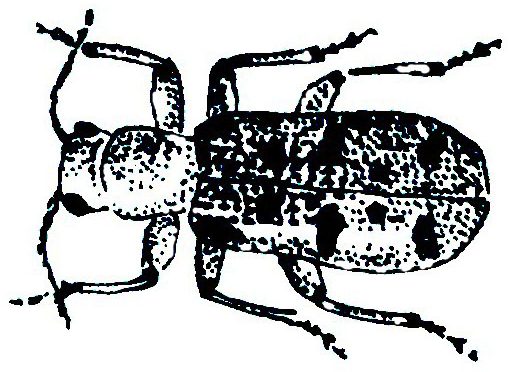
Spotted Asparagus Beetle
0.25-0.3 in.
Cabbage Loopers and Cabbageworms
- Cover plants with cheesecloth or floating row covers until just before bloom; this prevents early egg laying.
- Handpick from plant. The green worms are much easier to spot on red-leaf varieties.
- Spray plants with Bacillus thuringiensis (Bt) when worms are still small (less than 1/4 inch).
- Remove alternate host weeds, such as wild mustard and shepherd’s purse, from the garden.
- Many solitary wasps collect and paralyze small caterpillars for nests so that their young have fresh prey when they hatch after the nest cell is sealed. Cavity nests for solitary bees are utilized by solitary wasps. Solitary wasps are never aggressive since they have no colony to protect.

Imported Cabbageworm
1.25-2.0 in.
Colorado Potato Beetle
- Potato beetles prefer to feed on potato, eggplant, and tomato. Rotate these preferred hosts with other crops in alternate years.
- Handpick orange egg masses, reddish brown larvae, and yellow-and-black striped adults and destroy.
- Place straw mulch around plantsasabarriertobeetle colonization of plants in spring.
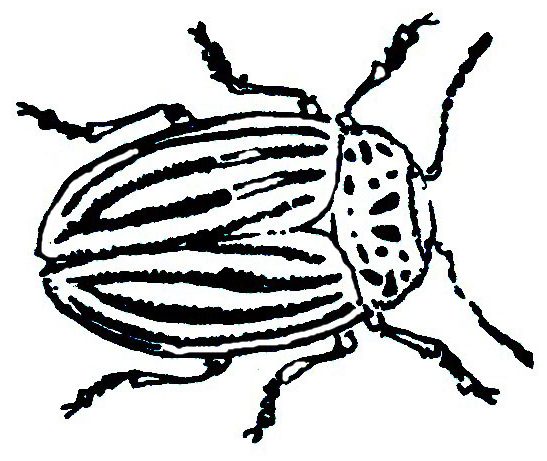
Colorado Potato Beetle
0.4 in.
Corn Earworm (Tomato Fruitworm)
- With no controls applied, earworms usually damage only the tip of the corn. Cut off the damaged tips and you can eat the rest.
- Select tight-husked corn varieties for planting. Tight husks inhibit worm movement into the ear.
- Plant and harvest corn as early in the season as possible to avoid heavy infestations.
- Drop 1/4 teaspoon of mineral oil on the silks of each corn ear after the silks have wilted but before they begin to dry. This helps to repel moths and egg laying.
- If possible, avoid planting other vegetables near corn, as the worms also feed on other vegetables.
- On tomatoes, beginning at the flower stage, check upper leaves once a week for small, round, white fruitworm eggs. Spray plants
with Bacillus thuringiensis weekly as long as you detect eggs.
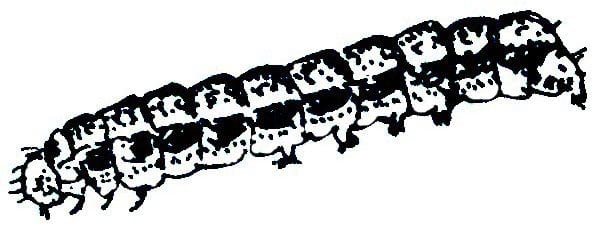
Corn Earworm
1.5 in.
Cucumber Beetles
- Plant nonbitter cucumber varieties; the bitter compound in cucumber attracts beetles.
- Cover plants with cheesecloth or floating row covers until just before bloom. This prevents early egg laying.
- Eliminate weeds in and around the garden. Some weeds are hosts for bacterial wilt disease that is spread by cucumber beetles.
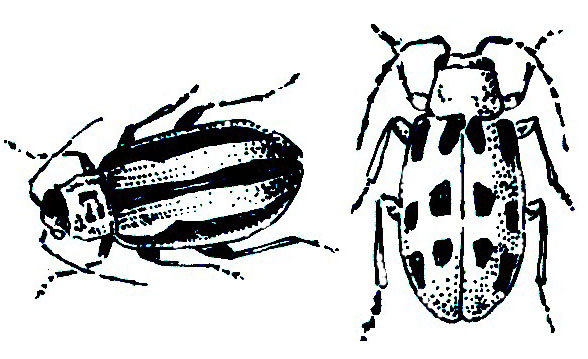
Striped (left) & Spotted (right) Cucumber Beetles
0.2-0.25 in.
Flea Beetles
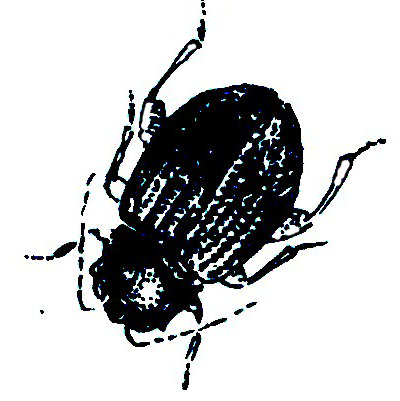
Potato Flea Beetle
0.05-0.08 in.
- Unless flea beetle populations are heavy, their feeding does not kill plants or reduce yields. Control is usually unnecessary.
- Flea beetles are most numerous in spring. Plant susceptible crops, such as eggplant and radish, later in the season.
- Weeds bordering the garden may serve as alternate hosts. Removing weeds could reduce flea beetle populations but may also reduce predatory insect populations.
False Chinch Bugs
- False chinch bugs are weed-feeding insects that may build up in large numbers during arid conditions. They migrate in huge numbers that may overwhelm any control efforts.
- Early-season control of cruciferous weed hosts, such as wild mustard or hairy bittercress, may help to reduce numbers.
- If damage from false chinch bugs reaches unacceptable levels, treatments to field edges will help control this pest.
- False chinch bugs are easily drowned. Heavy watering or use of a strong hose spray will drown many. Any overhead watering should occur early in the day to allow plants to dry before dusk. Trenches or pans of water attract and trap these pests. Place around plants during periods of insect migration.
Grasshoppers
- Grasshoppers occasionally cause serious damage or crop losses.
- Trap grasshoppers by using a 1 quart container half filled with a 10 percent molasses and water mixture.
- Grasshopper populations are most damaging in late summer. Use a floating row cover to protect late- season plantings.
- If problematic, plow the garden in fall to expose grasshopper eggs to the weather and insect predators. Be sure to plow fence rows and garden borders too.
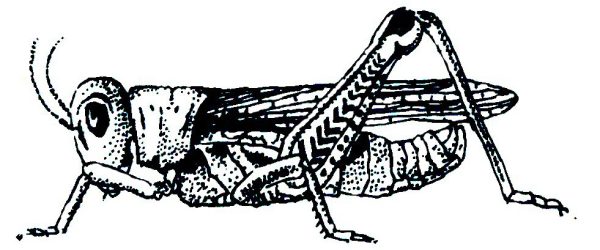
Differential Grasshopper
1.5-2.0 in.
Japanese Beetles
- Avoid planting gardens near lawns or in land previously containing lawns.
- Protect plants with floating row covers.
- Japanese beetles tend to emerge all at once, with adults maturing simultaneously. Handpick or let them fall into a bucket of soapy water in the early morning during the first few days of emergence. This also reduces their chemical signaling to other adults that a good food source has been found.
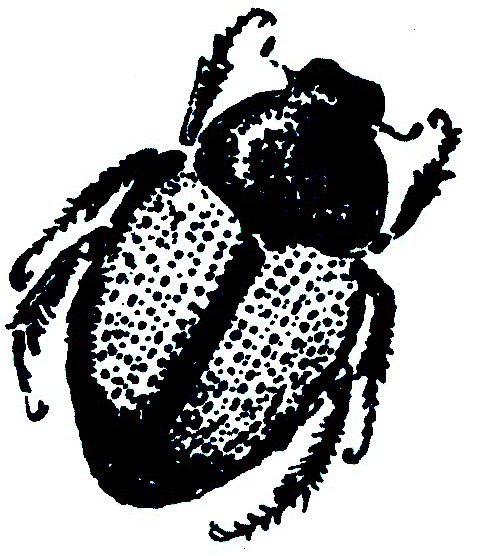
Japanese Beetle
0.3-0.5 in.
Leafhoppers
- Protect plants with cheesecloth or other fine mesh row covering.
- Yellow sticky cards attract and trap these flying pests. Replace when cards are full of insects.
- Spray plants with RTU insecticidal soap.
- Because leafhoppers can transmit viral diseases, remove diseased plants to delay spread to healthy plants.
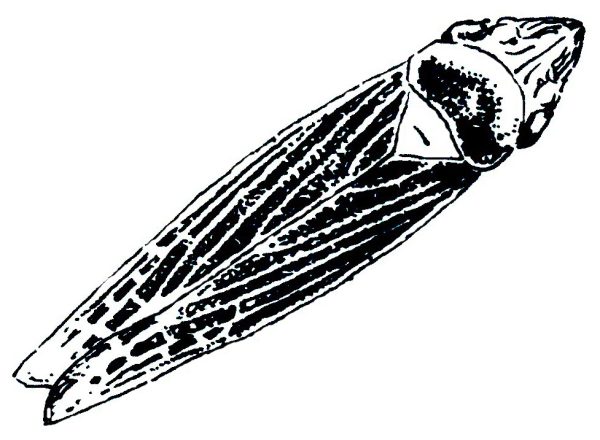
Leafhopper
0.05-0.25 in.
Mexican Bean Beetles
- Handpick and destroy egg masses and beetles in early morning before they become active.
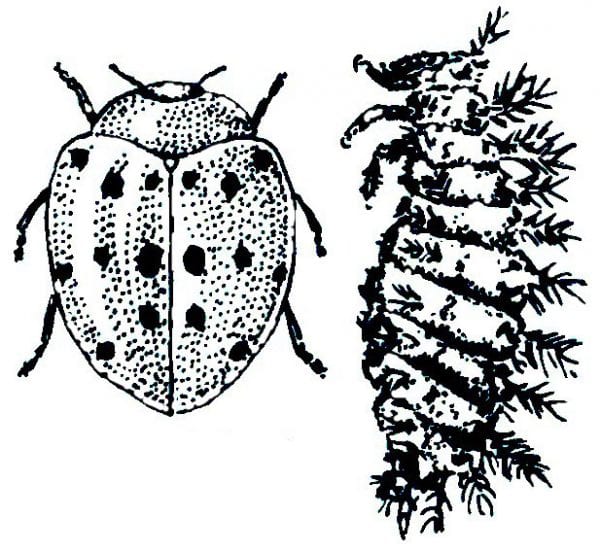
Mexican Bean Beetle, 0.25-0.33 in.(left)
Larva, 0.33 in. (right)
Spider Mites
- Spray plants with insecticidal soap.
- Cover plants with a frame and drape with an old blanket to create a cool, moist environment. Mites prefer hot, dry environments.
- Spray plants with water or RTU insecticidal soap then cover infested plants with a blanket for 3 days. Follow with a second soap spray.
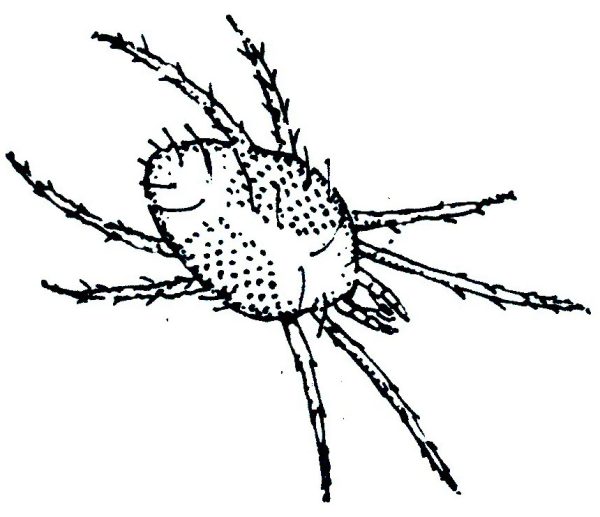
Twospotted Spider Mite
0.01-0.02 in.
Squash Bugs
- Remove and destroy clusters of oval, orange- brown squash bug eggs on squash leaves or nearby surfaces. Note that similar egg clusters, positioned upright and often yellow, may be lady beetle (ladybug) eggs. These are beneficial insect predators.
- Remove and destroy squash vines and unused fruit during the season and after harvest to eliminate overwintering sites.
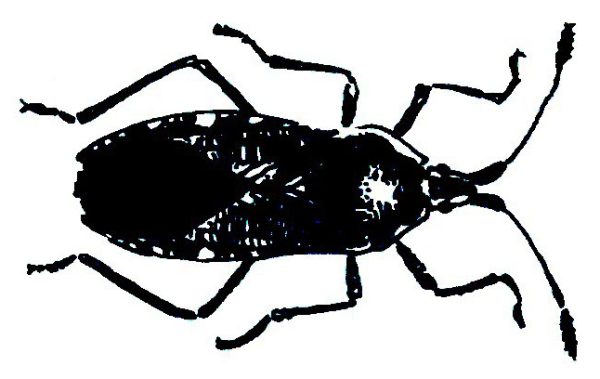
Squash Bug
0.7 in.
Squash Vine Borers
- Cover plants with fine mesh cloth or row cover until female flowers appear. Female flowers have a bulge between flower and stem that is absent in male flowers.
- Plant squash varieties with long vines. These varieties of squash may continue to grow despite borer damage.
- Plant in late summer or fall to avoid heavy vine borer infestations.
- Cut open borer entry holes in the stem with a sharp knife. Remove the worm and pack moist earth around the cut stem.
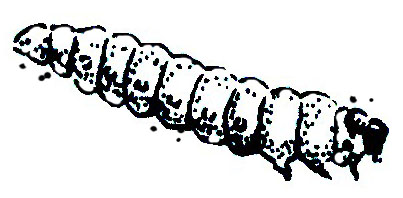
Squash Vine Borer
1.0 in.
Tomato Hornworms
- Handpick worms from plants. Check plants in the evening with a flashlight. Look underneath leaves during the day.
- Spray Bacillus thuringiensis when the worms are still small (less than 1/2 inch).
- Plant dill next to tomatoes as a preferred trap crop. Handpick worms from the dill.
- Do not destroy hornworms that have small, white cocoons attached to their bodies. These are cocoons from which small, parasitic wasps (beneficial) will emerge. Other infested hornworms may be nearby but appear healthy. If possible, pick these off the plants, place in container with tomato leaves, and place near the garden. The parasitic wasps often lay eggs in multiple caterpillars if available. Watch daily for cocoons to appear on these trapped caterpillars.
- Turn the soil in fall to expose hornworm pupae to weather and predators.
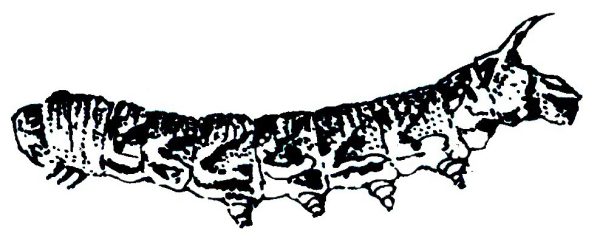
Tomato Hornworm
3.0-4.0 in.
Weevils (Bean Weevil or Cowpea Curculio)
- Plant resistant, thick-hulled southern pea varieties.
- Plant beans and peas as early as possible, and turn plants underground after harvest.
- Pick pods when somewhat green, and blanch before freezing. This kills weevil eggs and larvae, which are seldom seen in the frozen beans.
- Before storing dry beans, heat beans in a 175 degree Fahrenheit oven for an hour. Cool beans, then bag and freeze them for a week to kill any weevil larvae or eggs. After this, store beans at room temperature.
Whiteflies
- Whiteflies are rarely a problem in outdoor gardens. Inspect transplants before purchase to ensure they are not infested with whiteflies or other insects.
- Use yellow sticky cards to attract and trap the flies. Replace when full of insects.
- Spray plants with RTU insecticidal soap.
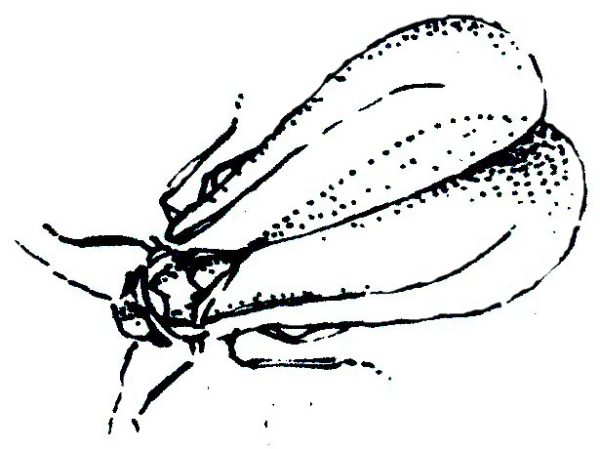
Greenhouse Whitefly
0.06 in.
 Revised by Kerry Smith, Outreach Programs Administrator, Home Grounds, Gardens, and Home Pests, and Meredith Shrader, Diagnostician, Entomology, both with Auburn University. Originally written by Charles Ray, former Extension Research Fellow; Geoff Zehnder, former Extension Entomologist; and Meredith Shrader, Diagnostician, Entomology, Auburn University
Revised by Kerry Smith, Outreach Programs Administrator, Home Grounds, Gardens, and Home Pests, and Meredith Shrader, Diagnostician, Entomology, both with Auburn University. Originally written by Charles Ray, former Extension Research Fellow; Geoff Zehnder, former Extension Entomologist; and Meredith Shrader, Diagnostician, Entomology, Auburn University
Revised July 2023, Garden Bugs: Insect Pest Management in Home Vegetable Gardens, ANR-1045

